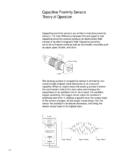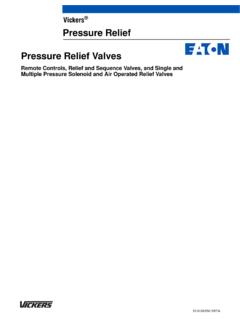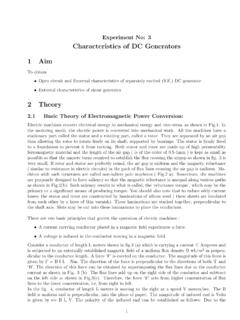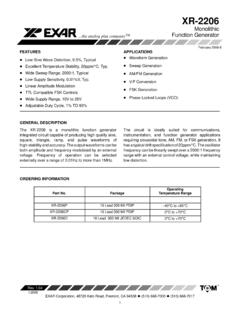Transcription of TUTORIAL - Analog Devices
1 , 09/2011, WK Page 1 of 7 MT-083 TUTORIAL Comparators COMPARATOR BASICS A comparator is similar to an op amp. It has two inputs, inverting and non-inverting and an output (see Figure 1). But it is specifically designed to compare the voltages between its two inputs. Therefore it operates in a non-linear fashion. The comparator operates open-loop, providing a two-state logic output voltage. These two states represent the sign of the net difference between the two inputs (including the effects of the comparator input offset voltage).
2 Therefore, the comparator's output will be a logic "1" if the input signal on the non-inverting input exceeds the signal on the inverting input (plus the offset voltage, Vos) and a logic "0" for the opposite case. A comparator is normally used in applications where some varying signal level is compared to a fixed level (usually a voltage reference). Since it is, in effect, a 1-bit Analog -to-digital converter (ADC), the comparator is a basic element in all ADCs. (See MT-011 for details of comparator operation as an ADC building block).
3 Figure 1: Comparator Symbol Comparator dc specifications are similar to those of op amps: input offset voltage, input bias current, offset and drift, common-mode input range, gain, CMR, and PS R. Standard logic-related dc, timing, and interface specs are associated with the comparator outputs. The key comparator ac specification is propagation delay (see Figure 2): it is the time required for the output to reach the 50% point of a transition, after the differential input signal crosses the offset voltage when driven by a square wave (typically 100 mV in amplitude) to a prescribed value of input overdrive (usually 5 mV or 10 mV).
4 The propagation delay in practical comparators decreases somewhat as the input overdrive is increased. This variation in propagation delay as a function of overdrive is called dispersion as shown in Figure 3. Page 2 of 7 MT-083 Figure 2: Comparator Propagation Delay Figure 3: Comparator Delay Dispersion COMPARATOR HYSTERESIS The addition of hysteresis, which is application of a small amount of positive feedback, to a comparator's transfer function is often useful in a noisy environment, or where it is undesirable for the comparator to toggle continuously between states when the input signal is at or near the switching threshold.
5 This is true when a relatively slowly changing input is compared to a dc level. Noise can cause the output to toggle between the output levels many times. The transfer function for a comparator with hysteresis is shown in Figure 4. Page 3 of 7 MT-083 If the input voltage approaches the switching threshold (VOS) from the negative direction, the comparator will switch from a "0" to a "1" when the input crosses VOS + VH/2. The "new" switching threshold now becomes VOS VH/2. The comparator output will remain in a "1" state until the threshold VOS VH/2 is crossed, coming from the positive direction.
6 Input noise centered around VOS will not cause the comparator to switch states unless it exceeds the region bounded by VOS VH/2. Figure 4: Effects of Hysteresis Hysteresis can be accomplished with two resistors (see Figure 5), and the amount of hysteresis is proportional to the resistors ratio. The signal input to the comparator may be applied to either the inverting or the non-inverting input, but if it is applied to the inverting input its source impedance must be low enough to have insignificant effect on R1 (of course if the source impedance is sufficiently predictable it may be used as R1).
7 VSR1R1 + R2 Figure 5: Application of Hysteresis If the trip voltage is midway between the two comparator output voltages (as is the case with a symmetrical power supply and a ground reference) then the introduction of hysteresis will move Page 4 of 7 MT-083 the positive and negative thresholds equal distances from the trip point voltage, but if the trip point is nearer to one output than to the other the thresholds will be asymmetrically placed about the trip point voltage. To calculate the hysteresis, assume the comparator output voltages are VP and VN respectively.
8 The comparator trip point voltage is VTP . The negative threshold is: 2RV1RV)2R1R(THRESHOLDNEGATIVENTP += Eq. 1 And the positive threshold voltage is: 2RV1RV)2R1R(THRESHOLDPOSITIVEPTP += Eq. 2 An example of how external hysteresis improves comparator response is shown in Figure 6. Figure 6: Hysteresis Helps Clean Up Comparator Response A problem encountered with external hysteresis is that the output voltage depends on supply voltage and loading. This means the hysteresis voltage can vary from application to application; though this affects resolution, it need not be a serious problem, since the hysteresis is usually a very small fraction of the range and can tolerate a safety margin of two or three (or more) times what one might calculate.
9 Swapping in a few comparators can help confidence in the safety margin. Don't use wirewound resistors for feedback; their inductance can make matters worse. Don't forget that adding additional hysteresis to a comparator also reduces the comparators effective resolution. The minimum resolvable signal is equal to the difference in the threshold voltages, VP VN. Some comparators have hysteresis built in an example of this is the AD790 (see Figure 7). The hysteresis voltage is nominally 500 V. This, of course, can be overridden by applying external hysteresis.
10 NO EXTERNAL HYSTERESIS5 mV EXTERNAL HYSTERESIS Page 5 of 7 MT-083 The AD790 has an additional advantage. The supplies on the input ( Analog ) side are not necessarily those on the output. The output swing is from VLOG IC to GND. The input supplies can be 15 V down to +5 V and Ground. Figure 7: AD790 Block Diagram. It is quite common for the output of a comparator to be open collector (TTL logic) or open drain (CMOS logic). This allows interfacing to whatever logic level is appropriate to the following circuitry. Note that the maximum allowable output voltage must be observed, but this is usually not too great an issue.

















